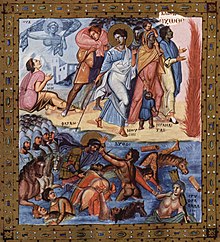This article includes a list of references, related reading, or external links, but its sources remain unclear because it lacks inline citations. (February 2022) |

| Part of a series on the |
| History of Greek art |
|---|
 |
Macedonian art is the art of the Macedonian Renaissance in Byzantine art style. The period in which the art was produced, the Macedonian Renaissance, followed the end of the Byzantine iconoclasm era lasting from 867-1056, concluding with the fall of the Macedonian dynasty. The advent of the Macedonian Empire allowed for a new era of Byzantium revival where many aspects of the empire flourished including quality of life, art, architecture, technology, and military prowess, ultimately leading to the empires Medieval peak.[1] This Macedonian era of the Byzantine empire was so prosperous it is considered the empire's Golden Age.[2] Additionally the empire coincided with the Ottonian Renaissance in Western Europe.
"Macedonian" refers to the ruling dynasty of the period, rather than where the art was created. The court-quality pieces have, as with other periods, traditionally thought to have mostly been created in the capital, Constantinople, or made by artists based or trained there, although art historians have begun to question whether this easy assumption is entirely correct.
- ^ "Web Login Service". newman.richmond.edu. Retrieved 2024-10-07.
- ^ Shea, Jonathan. "The Macedonian Dynasty (862–1056)". Dumbarton Oaks. Retrieved 2024-10-07.